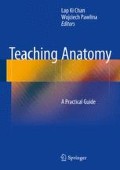Abstract
Medical school museums are a permanent educational resource that provides access at the individual’s convenience. They may be considered a supplemental approach to providing graduate and postgraduate medical students with materials for the study of not only anatomy, but also of other basic and clinical sciences, such as embryology, pathology, and surgery. Also, they could be developed as a valuable tool for earning credits for mandatory continuing medical education (CME) requirements for physicians.
Historically, medical school museums were a principal resource for teaching anatomy and surgery and were considered superior to most other educational materials since they allowed both self-directed learning and group study, providing a means to develop better professional communication skills, objectives that currently are emphasized in medical education. However, there was a dramatic decline in the role of museums as an educational tool, which resulted in either partial or complete neglect of their contents and replacement of their floor space with other educational facilities, such as lecture halls, classrooms, and study rooms. Many factors contributed to the decline of museum use: the high maintenance costs for an optional use facility, the large amount of floor space they occupy, which otherwise can be used for research activities that may attract extramural funds to the institution, and the remarkably widespread adoption of information technology and multimedia in medical education, including anatomy.
Existing medical school museums should never lose their value as scientific and pedagogic tools as long as anatomy and pathology remain essential foundations for clinical practice. Equipping museums with state-of-the-art information technology capabilities may be a means both of updating them and of encouraging their use in anatomy teaching as part of an integrated medical curriculum.
Access this chapter
Tax calculation will be finalised at checkout
Purchases are for personal use only
References
Cole FJ. A history of comparative anatomy: from Aristotle to the eighteenth century. 1st ed. London, UK: Macmillan & Co. Ltd.; 1949. 524 p.
Reinarz J. The age of museum medicine: The rise and fall of the medical museum at Birmingham’s School of Medicine. Soc Hist Med. 2005;18(3):419–37.
von Hagens G, Tiedemann K, Kriz W. The current potential of plastination. Anat Embryol. 1987;175(4):411–21.
Wakefield D. The future of medical museums: threatened but not extinct. Med J Aust. 2007;187:380–1.
Kronz JD, Silberman MA, Allsbrook WC, Epstein JI. A web-based tutorial improves practicing pathologists’ Gleason grading of images of prostate carcinoma specimens obtained by needle biopsy: validation of a new medical education paradigm. Cancer. 2000;89:1818–23.
Nola M, Morović A, Dotlić S, Dominis M, Jukić S, Damjanov I. Croatian implementation of a computer-based teaching program from the University of Kansas, USA. Croat Med J. 2005;46:343–7.
Cook DA, Dupras DM. A practical guide to developing effective web-based learning. J Gen Intern Med. 2004;19:698–707.
McCuskey RS, Carmichael SW, Kirch DG. The importance of anatomy in health professions education and the shortage of qualified educators. Acad Med. 2005;80:349–451.
Drake RL, McBride JM, Lachman N, Pawlina W. Medical education in the anatomical sciences: the winds of change continue to blow. Anat Sci Educ. 2009;2:253–9.
Clark D. Psychological myths in e-learning. Med Teach. 2002;24:598–604.
Cook DA. Web-based learning: Pros, cons and controversies. Clin Med. 2007;7:37–42.
Turk JL. The medical museum and its relevance to modern medicine. J R Soc Med. 1994;87:40–2.
Chen JC, Amar AP, Levy ML, Apuzzo ML. The development of anatomic art and sciences: the ceroplastica anatomic models of La Specola. Neurosurgery. 1999;45:883–91.
Barbian LT, Seldzik PS, Nelson AM. Case studies in pathology from the National Museum of Health and Medicine, Armed Forces Institute of Pathology. Ann Diagn Pathol. 2000;4(3):170–3.
Fulcheri E. The museums of pathologic anatomy: a very much neglected sector of scientific museology, worth of reconsideration. Pathologica. 1996;88:291–6.
Fraser R. Maude Abbott and the “Atlas of Congenital Cardiac Disease.” Cardiovasc Pathol. 2006;15:233–5.
Ferrari L, Coda R, Fulcheri E, Bussolati G. The role of the pathological anatomy museum: past glory, present crisis, and future prospects. Pathologica. 2001;93:196–200.
Naylor RA, Hollett LA, Castellvi A, Valentine RJ, Scott DJ. Preparing medical students to enter surgery residencies. Am J Surg. 2010;199:105–9.
Stewart M. Towards a global definition of patient centred care. BMJ. 2001;322:444–5.
Reilly JM, Ring J, Duke L. Visual thinking strategies: a new role for art in medical education. Fam Med. 2005;37:250–2.
Dolev JC, Friedlaender LK, Braverman IM. Use of fine art to enhance visual diagnostic skills. JAMA. 2001;286:1020–1.
Boisaubin EV, Winkler MG. Seeing patients and life contexts: the visual arts in medical education. Am J Med Sci. 2000;319:292–6.
Biggerstaff DE, Schnitz GW, Wingrove MS. Enhanced communication skills for medical students through drawing. J Biocommun. 1984;11:2–4.
Turk JL. Syphilitic caries of the skull: the changing face of medicine. J R Soc Med. 1995;88:146–8.
Nesi G, Santi R, Taddei GL. Historical outline of the Museum of pathological anatomy in florence. Med Secoli. 2007;19:295–303.
Marreez YMA-H, Willems LNA, Wells MR. The role of medical museums in contemporary medical education. Anat Sci Educ. 2010;3(5):249–53.
Shibata S, Manabe T, Yamashita K, Kajita H. Role of the medical museum in teaching medical students. Arch Pathol Lab Med. 1991;115:539–43.
Kawasaki. Medical Museum Kawasaki Medical School, Kurashiki. Japan: Okayama. 2010. http://www.kawasaki-m.ac.jp/mm/eng/
Acknowledgment
The authors would appreciate William Roy, PhD, for his kind review of this work.
Author information
Authors and Affiliations
Corresponding author
Editor information
Editors and Affiliations
Rights and permissions
Copyright information
© 2015 Springer International Publishing Switzerland
About this chapter
Cite this chapter
Marreez, Y.M.AH., Willems, L.N.A. (2015). The Use of Medical School Museums in Teaching “Anatomy” Within an Integrated Medical Curriculum. In: Chan, L., Pawlina, W. (eds) Teaching Anatomy. Springer, Cham. https://doi.org/10.1007/978-3-319-08930-0_30
Download citation
DOI: https://doi.org/10.1007/978-3-319-08930-0_30
Published:
Publisher Name: Springer, Cham
Print ISBN: 978-3-319-08929-4
Online ISBN: 978-3-319-08930-0
eBook Packages: MedicineMedicine (R0)

